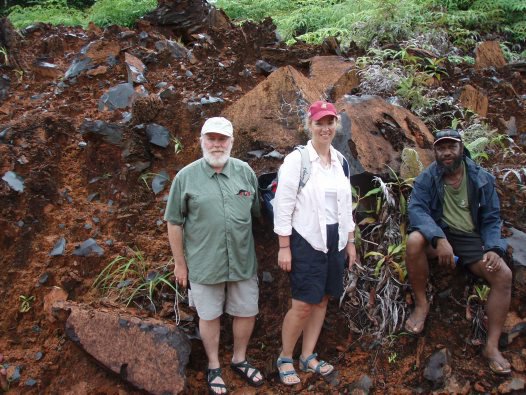Tracking ancient trade on Manus Island, Papua New Guinea
Obsidian was widely traded on Manus Island, Papua New Guinea where it was commonly used for tools such as knives and spears. Our recent discovery of a geological outcrop at Lepong not known to have been exploited in recent times has raised important questions about the history of ancient trade. Chemical analyses using three techniques showed that artifacts from SW Manus assumed to be very old due to the high degree of weathering may be derived from the new source. These results highlight how much there is still to learn about the history of ancient trade in this region.

Fieldwork team discovers the new obsidian source at Lepong, Manus. L-R: Professor Glenn Summerhayes (University of Otago); Professor Lisa Matisoo-Smith (University of Otago); Herman Mandui (National Museum of Papua New Guinea).
Image: Glenn Summerhayes© Otago University
Often you just can’t predict how significant a new discovery is going to be, especially when the research involves multiple analytical techniques conducted by scientists working independently at different research institutions. The results of our studies on obsidian from a new source of obsidian in Papua New Guinea came as a pleasant surprise. Glenn Summerhayes, Professor of Archaeology at Otago University and a Research Associate at the Australian Museum Research Institute, has inspired many people in Papua New Guinea with his enthusiasm for and dedication in pursuing archaeological fieldwork in the region.
The late Father Paul Mohe, who was the head of the Catholic Church in Manus Province, was fascinated by Glenn’s stories about the ancient past. So when Father Mohe heard from one of his parishioners about a place called Lepong where road building had uncovered a place with shiny black rocks, he contacted Glenn and helped organise a boat trip to check out whether this was a previously unknown geological source of obsidian, the glassy stone used widely on the island in ancient times for stone knives, daggers, and spears.

© Otago University
Having finally arrived at the isolated location, they were amazed to find abundant quantities of large boulders of obsidian suitable for making ancient tools. Surprisingly, the local people had no knowledge of their ancestors using and trading this potential rich resource. It was always thought by Manus residents and archaeologists alike that all the obsidian widely used for tools in this region had been traded from the quarries on the small island of Lou located to the south of the mainland. Had the people living near Lepong really ignored this seemingly rich resource? And if so, why?
To answer these questions, a team of experts was brought in to use a battery of techniques that could compare the chemical composition of the new obsidian from Lepong with ancient artefacts from archaeological sites in other areas of Manus Island. Robin Torrence of the Australian Museum Research Institute ran samples at ANSTO (Australian Nuclear Science and Technology Organisation) using a method called PIXE-PIGME; Wal Ambrose and Christian Reepmeyer at the Australian National University (ANU) applied LA ICP-MS; and Glenn Summerhayes collaborated with Charlotte Allen at the ANU using an electron microprobe (EDXA) within an electron scanning microscope (SEM).
When all the results are brought together, they demonstrate that although the Lou obsidian sources were used most often, a group of tools from an isolated and poorly known set of sites in SW Manus might be derived from the Lepong outcrops. Given these tools are highly weathered and resemble the forms of artefacts dating to the Pleistocene from the neighbouring island of New Britain, they suggest a very ancient trading route that did not continue into historic times.
The discovery of the Lepong obsidian source has clearly revealed how little we know about the history of trading systems in this region. Much more geochemical analysis involving larger samples of artefacts is required, but, thanks to the enthusiasm of Father Mohe and the productive collaboration of archaeological scientists in Australia and New Zealand, the rich and complex history of Papua New Guinea is now beginning to come to light.
Dr Robin Torrence
Senior Principal Research Scientist
More information:
Summerhayes, G. R., Kennedy, J., Matisoo-Smith, E., Mandui, H., Ambrose, W., Allen, C., Reepmeyer, C., Torrence, R., and Wadra, F. 2014. Lepong: a new obsidian source in the Admiralty Islands, Papua New Guinea. Geoarchaeology 29: 238-248. doi 10: 1002/gea.21475.

